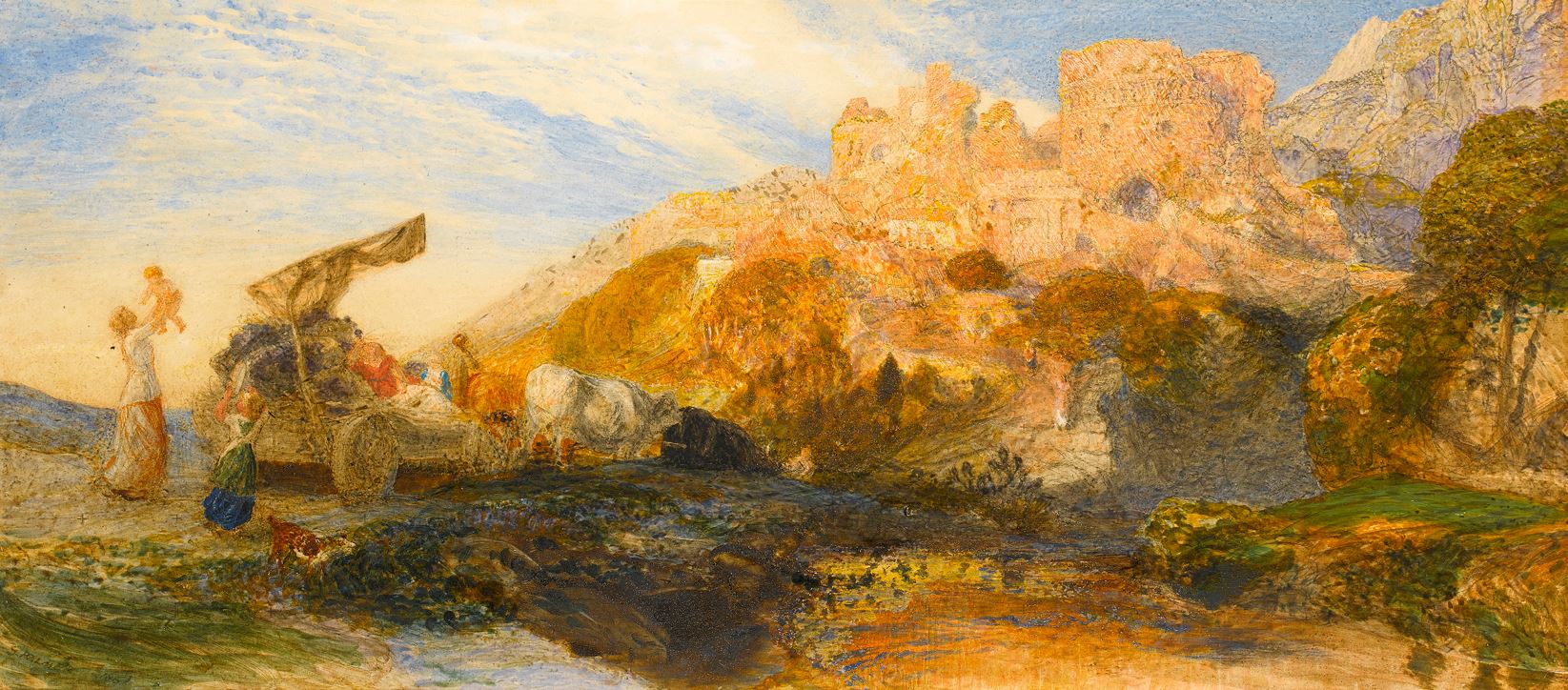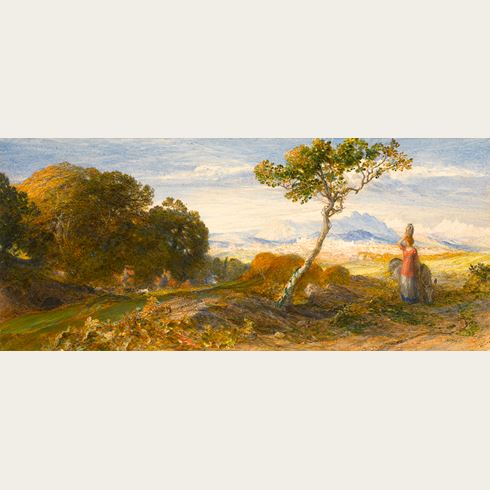Samuel PALMER
(Newington 1805 - Redhill 1881)
In Vintage Time
Sold
Watercolour, heightened with gouache and gum arabic, over an underdrawing in pencil.
Signed and dated S. PALMER 1861 at the lower left.
196 x 429 mm. (7 3/4 x 16 3/4 in.)
Signed and dated S. PALMER 1861 at the lower left.
196 x 429 mm. (7 3/4 x 16 3/4 in.)
This watercolour, depicting a peasant family returning home at sunset with a cart laden with grapes, was exhibited at the Old Water-Colour Society in 1861. It may have been intended as a pair with the following watercolour of the same size, In the Chequered Shade, which was also exhibited at the OWCS that year. The romantic Italianate landscape and strong colours, as well as the stippled effect and the extensive pencil underdrawing, are typical of Palmer’s mature work.
As William Vaughan has noted of his watercolours of this period, ‘Palmer had always been inclined to experiment with painting methods. With the abandonment of oil, he seems to have considered new ways of extending the power and range of watercolour...In his desire to strengthen effects Palmer developed practices already explored at Shoreham to augment watercolour with other media. He regularly added body colour and chalk to give his paints density. He even used glue to rival the viscosity of oil...By these methods he was able to retain a remarkable amount of purity of tone and delicacy of detail. His concern to use the best possible materials, the most reliable of pigments, was probably necessary in order for these effects to work. All in all, Palmer’s later watercolours are remarkable for their complexity.’
The format of this watercolour and its pendant is the so-called ‘little long’, measuring about 190 x 405 mm., which was Palmer’s preferred format for the watercolour drawings of his middle and later years. The horizontal format of these works allowed the artist to focus on the landscape, and the extensive pencil underdrawing and the highly finished stippled effect are also typical of Palmer’s mature draughtsmanship. Both of these watercolours may be closely related to other works of the early 1860s such as A Poet, which was exhibited at the Old Water-Colour Society the following year. Watercolours such as the present pair readily evoke not only Palmer’s experiences of Italy, but also often combine elements and motifs that are reminiscent of his travels in Shoreham, Devon and Wales.
As the author of a recent monograph on the artist has noted of Palmer, ‘his watercolours count amongst the finest of Victorian landscapes and are to be valued as well as part of the cultural life of that age.’
As William Vaughan has noted of his watercolours of this period, ‘Palmer had always been inclined to experiment with painting methods. With the abandonment of oil, he seems to have considered new ways of extending the power and range of watercolour...In his desire to strengthen effects Palmer developed practices already explored at Shoreham to augment watercolour with other media. He regularly added body colour and chalk to give his paints density. He even used glue to rival the viscosity of oil...By these methods he was able to retain a remarkable amount of purity of tone and delicacy of detail. His concern to use the best possible materials, the most reliable of pigments, was probably necessary in order for these effects to work. All in all, Palmer’s later watercolours are remarkable for their complexity.’
The format of this watercolour and its pendant is the so-called ‘little long’, measuring about 190 x 405 mm., which was Palmer’s preferred format for the watercolour drawings of his middle and later years. The horizontal format of these works allowed the artist to focus on the landscape, and the extensive pencil underdrawing and the highly finished stippled effect are also typical of Palmer’s mature draughtsmanship. Both of these watercolours may be closely related to other works of the early 1860s such as A Poet, which was exhibited at the Old Water-Colour Society the following year. Watercolours such as the present pair readily evoke not only Palmer’s experiences of Italy, but also often combine elements and motifs that are reminiscent of his travels in Shoreham, Devon and Wales.
As the author of a recent monograph on the artist has noted of Palmer, ‘his watercolours count amongst the finest of Victorian landscapes and are to be valued as well as part of the cultural life of that age.’
The son of a bookseller, Samuel Palmer lost his mother at an early age and was raised by a nurse, who introduced him to poetry and, in particular, the works of John Milton, for whom he was to have a lifelong passion. His only artistic training came in the drawing lessons he took as a youth, and it is due largely to a number of early encounters with other artists that his style developed. In 1822 he met John Linnell and, through him, was introduced to William Blake two years later. Both artists were to be formative influences on the young Palmer, with Blake, in particular, becoming a mentor and lifelong inspiration. Palmer’s devotion to landscape is evident from his earliest works, and by the second half of the 1820s he had begun to produce richly worked scenes of the countryside around Dulwich in London, treated as a kind of mysterious, fruitful and dreamlike garden.
This ‘visionary’ approach to the pastoral English landscape found its fullest expression when Palmer was living in the village of Shoreham in Kent, where he settled in 1826. The highly finished paintings and drawings of the Shoreham period, in the late 1820s and early 1830s, are regarded as the peak of Palmer’s early career. Painted and drawn in a rich combination of media, and characterized by an intensity of imagery and sentiment, his Shoreham works went against much of what was conventional in the landscape art of the day. (As David Blayney Brown has noted, ‘The inspired fantasy of Palmer’s Shoreham landscapes is unique in English art and can be matched only in the work of continental Romantics like Caspar David Friedrich and Philipp Otto Runge.’ At Shoreham, Palmer was associated with a small group of like-minded artists, including George Richmond and Edward Calvert, who called themselves ‘The Ancients’, but none were quite so committed to this radical vision of landscape as he was.
This resolutely single-minded and somewhat uncommercial approach could not last, however, and Palmer’s style began to change in the mid 1830s. He moved back to London and began travelling further afield, to Devon, Somerset and North Wales, in search of landscapes to paint. Following his marriage to Linnell’s daughter Hannah in 1837, and a two year honeymoon in Italy, Palmer’s work became distinguished by a brightness and clarity inspired by the light of the Mediterranean. The finished Italianate landscapes that he produced over the next three decades, executed in a rich technique of watercolour, gouache and gum arabic, are among his most attractive and appealing works.
In 1843 Palmer was elected an Associate of the Old Water-Colour Society, becoming a full member in 1854, and although he exhibited there annually, he found few patrons and had to work as a drawing-master to supplement his income. In 1865, however, he received his most important commission, for a series of very large watercolours illustrating Milton’s poems L’Allegro and Il Penseroso, from the solicitor Leonard Rowe Valpy. Palmer worked on these impressive watercolours over the next sixteen years until his death, and they account for some of his finest late work. He also produced a series of largely monochrome drawings, in pencil, charcoal, chalk, watercolour and ink, which were intended to illustrate his own translation of Virgil’s Eclogues. His skill as a draughtsman never faltered and was much admired into his old age; indeed ‘by the end of his life he was as effective – if less widely acknowledged – a master of bravura watercolour as any of his exhibiting contemporaries.’
Provenance
Walker’s Galleries, London, in 1952
Probably acquired from them by a private collector
Thence by descent until 2010.
Literature
‘Society of Painters in Water Colours [Second and Concluding Notice]’, The Illustrated London News, 8 June 1861, p.540; Alfred Herbert Palmer, Samuel Palmer: A Memoir, London, 1882, p.87; Alfred Herbert Palmer, The Life and Letters of Samuel Palmer, Painter and Etcher, London, 1892, [1972 ed.], p.411, no.107; Raymond Lister, Catalogue Raisonné of the Works of Samuel Palmer, New York, 1988, p.188, no.582 (as ‘Untraced since 1861’).
Exhibition
London, Society of Painters in Water-colours, 1861, no.216; London, Walker’s Galleries, 48th Annual Exhibition of Early English Water-Colours, 1952, no.86 (as The End of Day).






